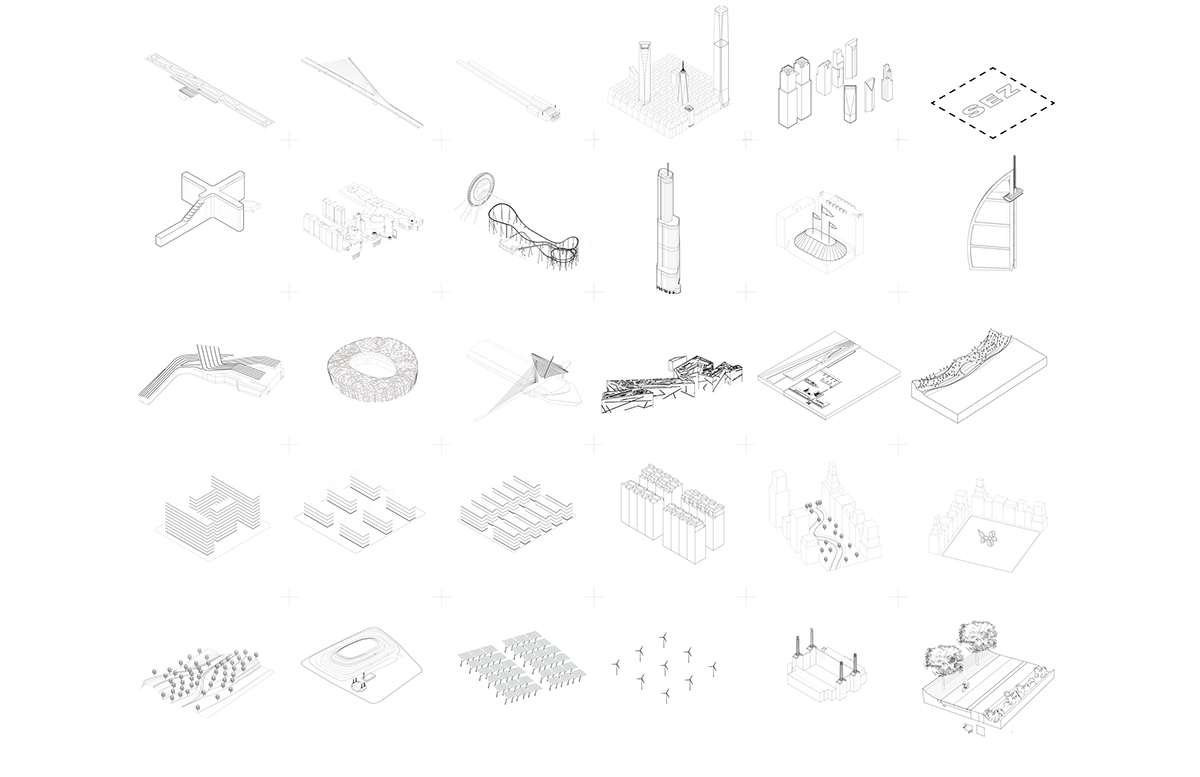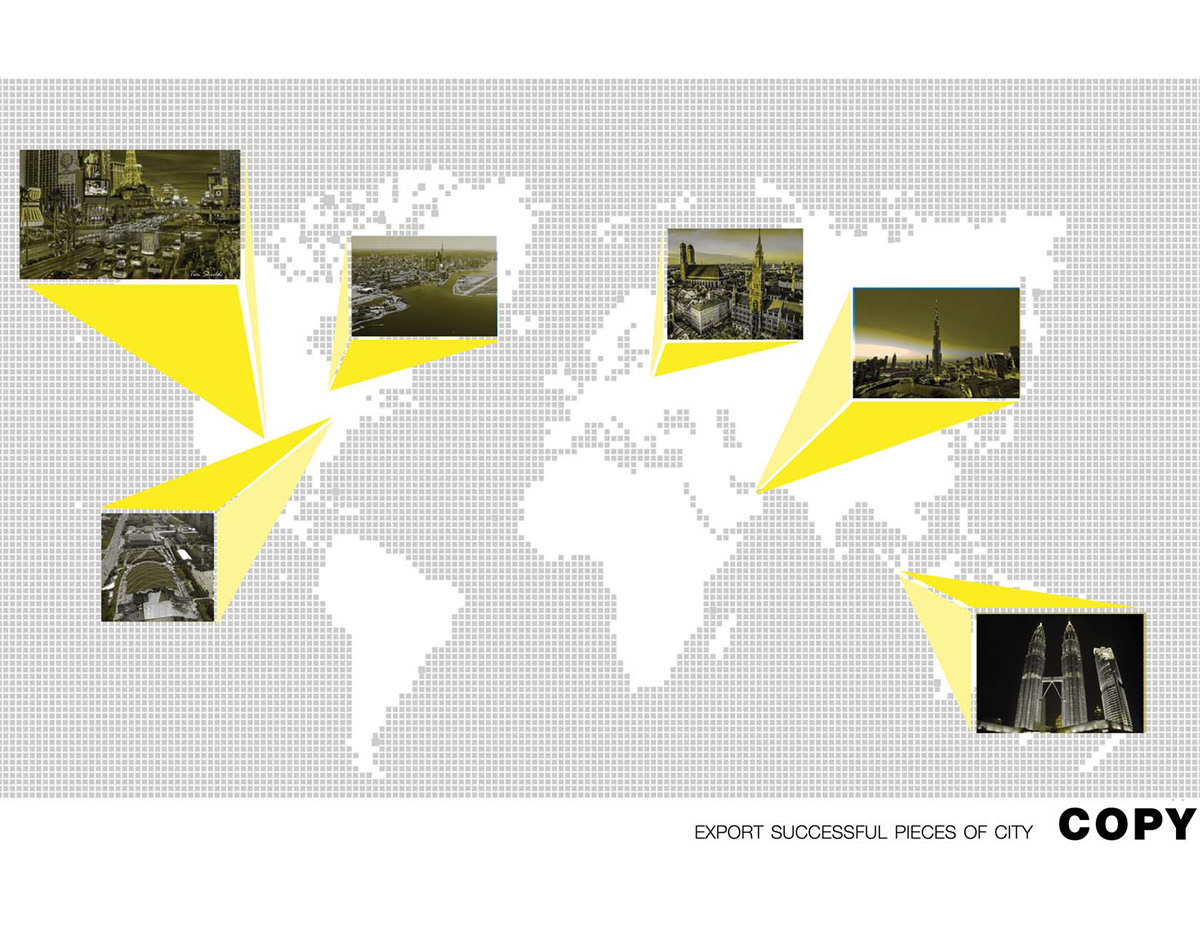Rome was not built in a day. But Madrid doubled its size less than 10 years. We now have the tools + technology to create entire cities in mere months. But with great power comes great responsibility. As designers, we are not the tool, we are the power behind them, we will no longer be used. We must learn from Madrid, as they are now planning new large scale projects after the expansion of their city which left them deep in debt. The definition of insanity is doing the same thing over and over again and expecting a different result. Yet the current emergence from a global economic crisis [caused by the housing market] is fueled by speculative planning and building of new cities across the world. We design the problem, if the global market collapses, will it be our fault? will Landscape Architecture design the [non-solution] evolution of our cities? We reject a packaged city as a kit of parts, objects without place or need for context. We therefore attempt to alter the notion of ‘city’ by using tools outside the toolbox.
This commercial itemizes the physical requirements for the ‘ideal city.’ Its first purpose is to inform the general public about this phenomenon of a commodifiable city, in which ideas and products can be bought and sold as easily as ikea furniture. Each piece is given a weight which will ‘transform’ an area, ‘fix’ a dying city, or work in unison with the other pieces to create an entire new ideal city. The public must understand the weight of this crisis, and be informed of the impact of these transplanted ideals to ‘fix’ cities and shape new ones without considering site or effect. This is how Madrid's massive investments in building and now stand vacant.
DISCLAIMER: This video is not meant to be offensive or saying that the tactics mentioned are always wrong, it is simply taking a stance by going to the extreme of saying urbanism has become commodified, like trading stocks or a kit of parts to buy. I believe appealing to the comedic side of the issues we are facing as designers and planners yields new tools to reach out beyond our own discipline to the general public for more accessible information. This leads to an interaction of design where designers are held to those who they desing for, not the politicains who need a pet project before their term is up or a developer looking a quick buck. ALL NUMBERS AND FIGURES STATED IN THIS VIDEO ARE SOURCED, THEIR SOURCES LISTED WITHIN THE VIDEO, HOWEVER THE CORPORATIONS/INSTITUTIONS SHOWN HAVE NO AFFILIATION WITH THIS PROJECT.
—100 years following the international style, we declare a rejection that architecture should be ‘styled’ at all. The international style revolted against the revival and proliferation of old styles, in order to embrace the new age of technology of mass production--towards a uniformity of architectural style complete with rules. Today, we see the same proliferation of ‘old styles,’ yet it comes in the form of a checklist of urban requirements. The apex of this 100 year period of uniformity has resulted in mass produced cities.
— We reject the commodification and flattening of design and cities and any set of rules that we must abide by in order to create a successful design, place, or city. Therefore, by analyzing, defining and illustrating the checklist of urban components, we strive for a deeper understanding of the current trends of how to create an ‘ideal’ city. These ideals are not real. Yet we strive to decipher who and what is proliferating these powerful ideals that define our cities. You must know the rules before you can break them
.
We enter a copy paste phenomenon —
a commodification of urban components whose ideas and pieces are traded like stocks. Thus, our existing cities flatten out to become an ‘international city’ devoid of individuality or place. As an idea is sold across the globe, the project’s value deflates, just as if it was a stock and everyone who wanted it could buy in. This process begins to occur on the city scale. Entire new cities will be mass produced, and sold like a self-assembly piece of ikea furniture.
— We declare a non-conformity. We will not simply accept the rules as prescribed. We reject the rules of international style and of the international city. The International Style created design solutions indifferent to location, site, and climate. without reference to local history or national vernacular. Today, we have been sold on the requirements of what a global city needs, indifferent to location—are we no better off than we were 100 years ago? Have we been convinced of this to an extent that we are constrained to what we can and cannot do in order to ‘sell’ a project to those with financial or political power? Thus far, it seems as if we as designers have been sold on the pieces of what a good city needs. We cannot leave the world to design new cities based on rankings or success stories, which can be packaged together and sold as a new investment option. It is convincing. It is deceiving.
We shall no longer allow media and professional groups to define urban form, or to give us an award and proliferate this idea of what they believe to be ‘good’ urbanism, which allows others to replicate + proliferate this cycle.. Designers shall no longer be pawns, technicians of sorts that only deliver the project that will sell. These publications and financial instutions shall be challenged, no longer will we accept the notion that our design is good simply because it has worked in other cities.
We declare the ‘ideal city’ to be dead. We have been striving for it since the 15th century, as perspective gave us a new way to express our ideals, which simultaneously occurred with the complete alteration of city form. Yet we are now in the digital world, where it is the programs we use and the ease of creating form, which drives and limits our projects. We must control our tools, not let them control us. They have the power to create uniform cities across the globe, but to what end? We shall not be pawns. We shall not conform to an ideal. It does not exist.
Adapt, grow, mutate; but do not clone. How else will we evolve? Darwinism prevails for cities, and as each strive for the ‘survival of the fittest’ the mutation which allowed one city to thrive, still soon be outcompeted when every other city has the same trait. When all cities look to copy the same project to define their city, the distinctions between them disappear and uniformity emerges. The city dies.
We declare this to be [R]Evolutionary Urbanism
http://publicsquare.cnu.org/open-source-congress-2013/ironic-ideas-to-inspire-new-audiences
—100 years following the international style, we declare a rejection that architecture should be ‘styled’ at all. The international style revolted against the revival and proliferation of old styles, in order to embrace the new age of technology of mass production--towards a uniformity of architectural style complete with rules. Today, we see the same proliferation of ‘old styles,’ yet it comes in the form of a checklist of urban requirements. The apex of this 100 year period of uniformity has resulted in mass produced cities.
— We reject the commodification and flattening of design and cities and any set of rules that we must abide by in order to create a successful design, place, or city. Therefore, by analyzing, defining and illustrating the checklist of urban components, we strive for a deeper understanding of the current trends of how to create an ‘ideal’ city. These ideals are not real. Yet we strive to decipher who and what is proliferating these powerful ideals that define our cities. You must know the rules before you can break them
.
We enter a copy paste phenomenon —
a commodification of urban components whose ideas and pieces are traded like stocks. Thus, our existing cities flatten out to become an ‘international city’ devoid of individuality or place. As an idea is sold across the globe, the project’s value deflates, just as if it was a stock and everyone who wanted it could buy in. This process begins to occur on the city scale. Entire new cities will be mass produced, and sold like a self-assembly piece of ikea furniture.
— We declare a non-conformity. We will not simply accept the rules as prescribed. We reject the rules of international style and of the international city. The International Style created design solutions indifferent to location, site, and climate. without reference to local history or national vernacular. Today, we have been sold on the requirements of what a global city needs, indifferent to location—are we no better off than we were 100 years ago? Have we been convinced of this to an extent that we are constrained to what we can and cannot do in order to ‘sell’ a project to those with financial or political power? Thus far, it seems as if we as designers have been sold on the pieces of what a good city needs. We cannot leave the world to design new cities based on rankings or success stories, which can be packaged together and sold as a new investment option. It is convincing. It is deceiving.
We shall no longer allow media and professional groups to define urban form, or to give us an award and proliferate this idea of what they believe to be ‘good’ urbanism, which allows others to replicate + proliferate this cycle.. Designers shall no longer be pawns, technicians of sorts that only deliver the project that will sell. These publications and financial instutions shall be challenged, no longer will we accept the notion that our design is good simply because it has worked in other cities.
We declare the ‘ideal city’ to be dead. We have been striving for it since the 15th century, as perspective gave us a new way to express our ideals, which simultaneously occurred with the complete alteration of city form. Yet we are now in the digital world, where it is the programs we use and the ease of creating form, which drives and limits our projects. We must control our tools, not let them control us. They have the power to create uniform cities across the globe, but to what end? We shall not be pawns. We shall not conform to an ideal. It does not exist.
Adapt, grow, mutate; but do not clone. How else will we evolve? Darwinism prevails for cities, and as each strive for the ‘survival of the fittest’ the mutation which allowed one city to thrive, still soon be outcompeted when every other city has the same trait. When all cities look to copy the same project to define their city, the distinctions between them disappear and uniformity emerges. The city dies.
We declare this to be [R]Evolutionary Urbanism
KIT OF PARTS:

REPRESENTED IN PHYSICAL FORM THROUGHOUT SPAIN







